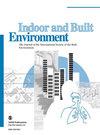喷水颗粒直径和流速对纵向通风隧道内烟雾流动和后分层的影响
IF 2.9
3区 工程技术
Q2 CONSTRUCTION & BUILDING TECHNOLOGY
引用次数: 0
摘要
隧道发生火灾时,燃烧释放的热量难以散去,隧道内的温度会迅速升高。纵向通风(LV)作为隧道火灾中常用的烟雾控制策略,对保护隧道结构和被困人员至关重要。除了纵向通风的烟雾控制方法外,水雾系统(WMS)也能为隧道内的高温烟雾提供强大的冷却效果。本文旨在研究水雾系统对 LV 的烟雾反分层(BL)长度的影响,以及烟雾扩散与水雾系统之间的相互影响过程。研究结果表明,在水雾和 LV 的共同作用下,烟雾反向分层长度受到了更有效的限制。启动 WMS 后,水雾的作用会抑制烟雾向上游扩散的能力,并导致烟雾层沉降,从而扰乱烟雾层的稳定性。不稳定的烟雾层更容易被纵向通风吹向下游。所有水雾颗粒直径都显示,随着流速的增加,烟雾反向分层显著减少。随着颗粒直径的减小,BL 长度也会逐渐减小。流速和颗粒直径对 BL 长度的影响与临界速度(Vcr)的影响相似。Vcr 会随着流速的增加而减小,并随着颗粒直径的增大而增大。本文章由计算机程序翻译,如有差异,请以英文原文为准。
Influence of the water spray particle diameter and flow rate on the smoke flow and the back-layering in tunnels with longitudinal ventilation
When there is a fire in a tunnel, the heat released by the combustion is difficult to dissipate and the temperature inside the tunnel would rise rapidly. Longitudinal ventilation (LV) has been commonly adopted as the smoke control strategy in tunnel fires, which is essential to safeguard the tunnel structure and the trapped people. Besides the smoke control method by LV, the water mist system (WMS) can provide a powerful cooling effect for the high-temperature smoke in the tunnel. This article aims to investigate the impact of WMS on the smoke back-layering (BL) length with LV and the mutual effect process between the smoke spread and the WMS. The findings show that the BL length is restricted more effectively by the combined action of water mist and LV. Upon activation of the WMS, the water mist’s effect inhibits the smoke’s ability to spread upstream and causes the smoke layer to settle down, which disturbs the stability of the smoke layer. An unstable layer of smoke is more likely to be blown downstream by longitudinal ventilation. All water mist particle diameters show a significant reduction in smoke back-layering with an increased flow rate. The BL length would gradually reduce as the particle diameter is decreased. The tendency of flow rate and particle diameter on the BL length shows similar effects to the critical velocity ( Vcr). The Vcr is reduced with the rising flow rate and increased with expanding particle diameter.
求助全文
通过发布文献求助,成功后即可免费获取论文全文。
去求助
来源期刊

Indoor and Built Environment
环境科学-工程:环境
CiteScore
6.40
自引率
25.00%
发文量
130
审稿时长
2.6 months
期刊介绍:
Indoor and Built Environment publishes reports on any topic pertaining to the quality of the indoor and built environment, and how these might effect the health, performance, efficiency and comfort of persons living or working there. Topics range from urban infrastructure, design of buildings, and materials used to laboratory studies including building airflow simulations and health effects. This journal is a member of the Committee on Publication Ethics (COPE).
 求助内容:
求助内容: 应助结果提醒方式:
应助结果提醒方式:


